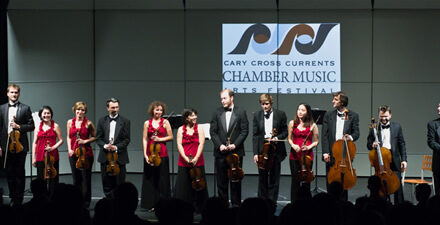Three poised and energized musicians entered the intimate hall of the Unitarian Universalist Congregation of Asheville on February 1, 2015. Violinist Ginger Kowal, violist Kara Poorbaugh, and cellist Franklin Keel are members of the Opal String Quartet, a professional chamber ensemble formed in 2006. Originally including four members, the group has remained under the title “Opal String Quartet” despite the fluctuation in number of members over the years. Poorbaugh and Keel are both graduates of the Eastman School of Music, and all three ensemble members play in the Asheville Symphony Orchestra — Kowal since the age of thirteen.
Poorbaugh’s relaxed and easy-going demeanor welcomed the crowd and opened the performance by defining and demonstrating with the help of Kowal the “suspension,” a musical device often heard in the music of the Baroque era. The audience could clearly hear the tension and release of chords as the viola sustained a pitch and the violin moved on to a new note. This push and pull of pitch causes harmonic tension which is then later resolved. Suspension proved to be the salient trait of the first piece of the afternoon.
As the players began Corelli’s Trio Sonata, Op. 1, No. 1, in F Major, the ensemble exuded a beautiful blend of harmonies; no one part overshadowed the other. This piece featured four rather short and lively, varied movements. The ensemble breathed together, swaying into each phrase like dancers about to leap into a new pose. I fell into a dream-like state, lost in the melodies before me. This was interrupted, however, by a few misfired notes (sharp bow malfunctions) from the ensemble. The Adagio movement featured deliciously accented suspensions quickly pulling me back into the dreamy trance. All three musicians seemed to recognize the musical merit of the suspension and seemed to enjoy emphasizing these phrases. The fourth movement featured melodic dialogue, as if each part had a story to tell; one instrument would begin a phrase, while another would “respond” with a series of notes. Sometimes these phrases were interrupted or joined by another part, thus creating a cloud of gorgeous sound.
The second piece was introduced by a wild-eyed and lively Tim Winter, a local composer, who spoke before the premiere of his piece, String Trio. A resident of Saluda, Winter’s musical background ranges from playing the classical viola, to bass guitar, to falling in love with jazz. Winter explained his excitement over hearing his piece performed live for the first time, after it had only been an electronically-crafted melody for so long. His String Trio began with exposed plucked cello, which was then joined by plucked viola, whereupon the violin followed suit. It reminded me very much of watching parts of a machine, turning and churning together with their counterparts. This rather experimental piece transitioned to a few bars of bowed melodies, echoing those of the beginning. Despite the seemingly randomness of it all, the strange and somewhat dissonant chords still appeared to make sense. I glanced across the room and noticed Tim Winter, eyes closed, a slight smile resting on his face as his ears were happily met with his mind’s melodies as they came to life.
The second Winter piece, Rhapsody for Viola and Cello, was written for his wife, who sat beside him doing the performance. Featuring Keel and Poorbaugh, this romantic piece was much more melodious and hummable. The deep tones of Keel’s cello echoed that of a bassoon, for which the piece was originally composed. The tender execution of the piece seemed to move Mrs. Winter to don a smile that radiated from her heart as the lovely harmonies enveloped the audience.
After a brief intermission, the afternoon concluded with Beethoven’s String Trio, Op. 9, No. 3 in C minor. A four-movement piece featuring a healthy blend of varying tonalities and tempi, this concluding number spoke to my love of all things classical. Each performer exuded expressiveness indicative of his or her love for this particular piece: Keel’s expressive eyebrows furrowing into the phrases, then meeting his ensembles’ with attentiveness; Kowel’s marionette doll posture leaning metrically with each phrase, her own internal rhythm pulsing every measure; Poorbaugh’s perpetually raised eyebrows and poised figure, face placid with a semi-smile. The performers elatedly released the final note, bringing audience members to their feet for a standing ovation.
This Sunday’s performance offered an inviting and warm afternoon of music making comprised by jovial friends who combine artistry with companionship. Proceeds from the performance benefit the Unitarian Universalist Congregation of Asheville’s “Welcome Project,” a project dedicated to accommodating all visitors and enhancing the building’s welcoming appeal, size, and making the hall handicap-accessible.











